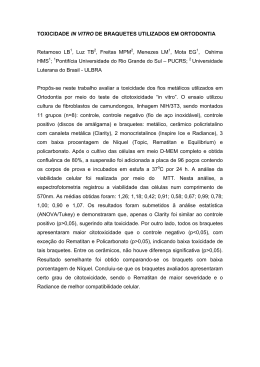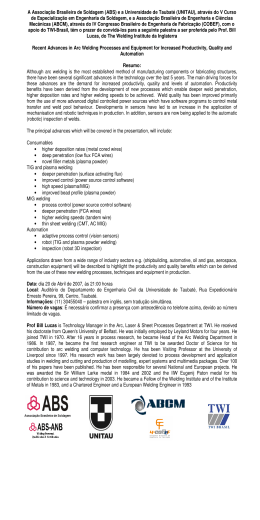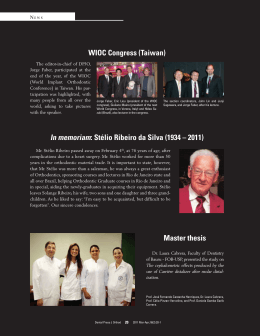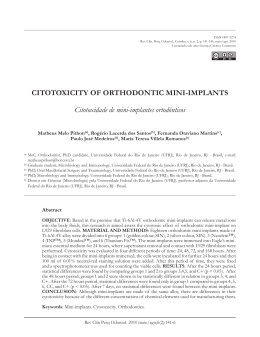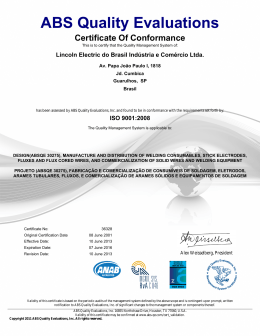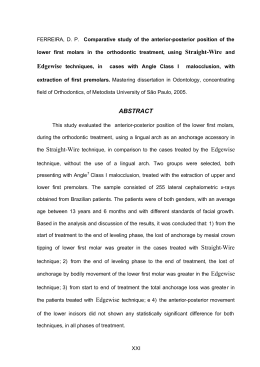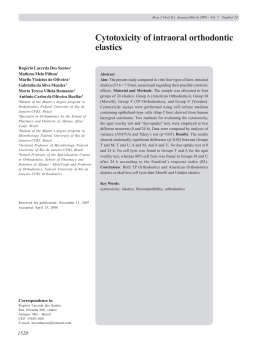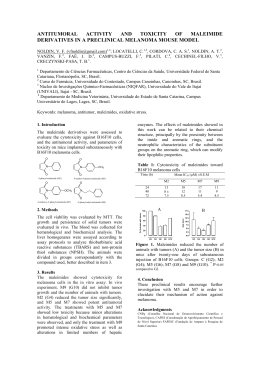Online Article* Cytotoxicity of electric spot welding: an in vitro study Rogério Lacerda dos Santos**, Matheus Melo Pithon***, Leonard Euler A. G. Nascimento****, Fernanda Otaviano Martins*****, Maria Teresa Villela Romanos******, Matilde da Cunha G. Nojima*******, Lincoln Issamu Nojima*******, Antônio Carlos de Oliveira Ruellas******* Abstract Objective: The welding process involves metal ions capable of causing cell lysis. In view of this fact, the aim of this study was to test the hypothesis that cytotoxicity is present in different types of alloys (CrNi, TMA, NiTi) commonly used in orthodontic practice when these alloys are subjected to electric spot welding. Methods: Three types of alloys were evaluated in this study. Thirty-six test specimens were fabricated, 6 for each wire combination, and divided into 6 groups: Group SS (stainless steel), Group ST (steel with TMA), Group SN (steel with NiTi), Group TT (TMA with TMA), Group TN group (TMA with NiTi) and Group NN (NiTi with NiTi). All groups were subjected to spot welding and assessed in terms of their potential cytotoxicity to oral tissues. The specimens were first cleaned with isopropyl alcohol and sterilized with ultraviolet light (UV). A cytotoxicity assay was performed using cultured cells (strain L929, mouse fibroblast cells), which were tested for viable cells in neutral red dye-uptake over 24 hours. Analysis of variance and multiple comparison (ANOVA), as well as Tukey test were employed (p<0.05). Results: The results showed no statistically significant difference between experimental groups (P>0.05). Cell viability was higher in the TT group, followed by groups ST, TN, SS, NS and NN. Conclusions: It became evident that the welding of NiTi alloy wires caused a greater amount of cell lysis. Electric spot welding was found to cause little cell lysis. Keywords: Toxicity. Cell culture techniques. Welding in dentistry. How to cite this article: Santos RL, Pithon MM, Nascimento LEAG, Martins FO, Romanos MTV, Nojima MCG, Nojima LI, Ruellas ACO. Cytotoxicity of electric spot welding: an in vitro study. Dental Press J Orthod. 2011 May-June;16(3):57-9. *Access www.dentalpress.com.br/revistas to read the full article. **Specialist in Orthodontics, Federal University of Alfenas - UNIFAL. Master and Doctor in Orthodontics, Federal University of Rio de Janeiro UFRJ. Adjunct Professor of Orthodontics, Federal University of Campina Grande - UFCG. ***Specialist in Orthodontics, Federal University of Alfenas - UNIFAL. Master and Doctor in Orthodontics, Federal University of Rio de Janeiro UFRJ. Assistant Professor of Orthodontics, State University of Southwestern of Bahia - UESB. ****Doctored Student in Orthodontics, Federal University of Rio de Janeiro - UFRJ. *****Graduated in Microbiology and Immunology, Federal University of Rio de Janeiro. Trainee of the Microbiology Institute of Prof. Paulo de Góes - UFRJ. ******PhD in Sciences (Microbiology and Immunology) by the Federal University of Rio de Janeiro - UFRJ. Adjunct Professor, Federal University of Rio de Janeiro - UFRJ. *******MSc and PhD in Orthodontics, Federal University of Rio de Janeiro - UFRJ. Adjunct Professor of Orthodontics, Federal University of Rio de Janeiro - UFRJ. Dental Press J Orthod 57 2011 May-June;16(3):57-9 Cytotoxicity of electric spot welding: an in vitro study Editor’s summary Some studies have shown that silver solder, although widely used in orthodontics, has some cytotoxic potential. In view of this fact, clinicians turn to spot welding as the method of choice for bonding orthodontic wires and accessories to achieve the desired orthodontic mechanics. Thus, the purpose of this study was to assess the cytotoxic potential of spot welding involving stainless steel, nickel-titanium (NiTi) and titanium-molybdenum (TMA) wires. Using rectangular 0.019x0.025-in wires welded together by means of an electric spot welder, six specimens were prepared for each of the following groups: SS (steel/steel), ST (steel/TMA), SN (steel/NiTi), TT (TMA/TMA), TN (TMA/NiTi) and NN (NiTi/NiTi). Copper amalgam was used as positive control, glass as negative control and for cell control, cells not previously exposed to any material. As negative control for each material cylinders made from stainless steel, nickeltitanium and TMA were utilized. After sterilization with ultraviolet light, the specimens were exposed for 24 h to a culture medium of L929 cells, i.e., mouse fibroblasts. Cytotoxicity was evaluated by the neutral red dye-uptake assay for viable cells. Data were subjected to ANOVA followed by Tukey’s multiple comparison test (p<0.05). Statistically significant differences were only found between groups NN (nickel-titanium) and cell control. Therefore, no cytotoxic potential was found in the spot welding of stainless steel wire, nickel-titanium and TMA. However, the group composed only of nickel-titanium alloy showed higher cytotoxicity compared to non-exposed cells (cell control), probably due to the large quantities of nickel comprised in this type of alloy. Questions to the authors providing guidance to professionals with regard to the choice of materials with improved biological characteristics. 1) Studies assessing the cytotoxicity and genotoxicity of materials used in orthodontics are uncommon despite the relatively prolonged use of different materials that remain in close contact with the oral mucosa during orthodontic treatment. In light of this fact, how important are studies such as this one? In recent years, the number of studies on cytotoxicity of orthodontic materials has increased significantly. This new reality represents a breakthrough in the area because it is not enough for a material to have good physical, mechanical, aesthetic features, among others. It should also be inert to oral tissues. Studies aimed at identifying materials capable of causing cellular damage will allow these materials to be classified, thereby Dental Press J Orthod 2) This study revealed greater cytotoxic potential of nickel-titanium alloy relative to the cell control group. Could this factor indicate a likely contribution of NiTi alloy to the process of carcinogenesis? This study on spot welding was motivated by the disclosure that silver solder has demonstrated a significant cytotoxic character. The World Health Organization International Agency for Research on Cancer, and the United States National Toxicology Program have determined that metal components in silver solder such as cadmium, copper, silver and zinc are potentially carcinogenic to humans. This study showed that spot welding between NiTi alloys had the 58 2011 May-June;16(3):57-9 Santos RL, Pithon MM, Nascimento LEAG, Martins FO, Romanos MTV, Nojima MCG, Nojima LI, Ruellas ACO tical, fast procedure and current machines have shown great effectiveness, which is also crucial. After undergoing spot welding, orthodontic wires appear cleaner and aesthetically pleasant, which attests to a decreased release of cytotoxic ions while facilitating polishing when necessary. Besides, there is certainly a direct relationship between the release of these ions and the results achieved in this study. One essential condition for the use of metallic materials in the oral environment is that these materials resist the corrosive action of saliva, as well as variations in pH and temperature. As an orthodontic material, silver solder is particularly susceptible to corrosion. Furthermore, the use of this solder for bonding orthodontic wires has been shown to cause the release of cytotoxic metallic ions, in part because silver solder polishing is usually inadequate, which facilitates the release of these ions. Therefore, spot welding has been used as a feasible and safe alternative in orthodontics. lowest cell viability, but within acceptable limits, i.e., above 80%. Arguably, only those orthodontic materials with less than 50% viability should be withdrawn from clinical use. Nickel’s notorious allergenic potential may be related to the lower viability found in this group. For David and Lobner,1 and Eliades et al2 there is clear evidence of a direct relationship between cytotoxicity and nickel but findings by Sestini et al3 showed that nickel and chromium caused a decrease in cell activity. Nickel’s role in the process of carcinogenesis still defies clarification, but these materials appear not to have a significant heightening effect in the process, which depends on the duration and amount of material in contact with oral cavity cells. 3) Given the results of your investigation, do you regard spot welding as a biologically safe orthodontic procedure? Electric spot welding has proven to be a prac- ReferEncEs 1. David A, Lobner D. In vitro cytotoxicity of orthodontic archwires in cortical cell cultures. Eur J Orthod. 2004 Aug;26(4):421-6. 2. Eliades T, Pratsinis H, Kletsas D, Eliades G, Makou M. Characterization and cytotoxicity of ions released from stainless steel and nickel-titanium orthodontic alloys. Am J Orthod Dentofacial Orthop. 2004 Jan;125(1):24-9. 3. Sestini S, Notarantonio L, Cerboni B, Alessandrini C, Fimiani M, Nannelli P, et al. In vitro toxicity evaluation of silver soldering, electrical resistance, and laser welding of orthodontic wires. Eur J Orthod. 2006 Dec;28(6):567-72. Dental Press J Orthod Submitted: February 2009 Revised and accepted: October 2009 Contact address Antônio Carlos de Oliveira Ruellas Av. Professor Rodolpho Paulo Rocco, 325 - Ilha do Fundão CEP: 21.941-617 - Rio de Janeiro / RJ, Brazil E-mail: [email protected] 59 2011 May-June;16(3):57-9
Download
